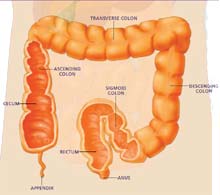Had Polyp Removed During Colonoscopy Started Menateration Again
What Is a Colon Polyp?
 Polyps are benign growths (noncancerous tumors or neoplasms) involving the lining of the bowel. They tin can occur in several locations in the gastrointestinal tract but are virtually mutual in the colon. They vary in size from less than a quarter of an inch to several inches in diameter. They wait like bumps growing from the inside lining of the bowel protruding out. They sometimes grow on a "stalk" and look similar mushrooms. Some polyps can exist flat. People can have several polyps scattered in different parts of the colon. Some polyps tin can incorporate cancer, although the vast bulk of polyps do non. Larger polyps are more than probable to become malignant than smaller ones.
Polyps are benign growths (noncancerous tumors or neoplasms) involving the lining of the bowel. They tin can occur in several locations in the gastrointestinal tract but are virtually mutual in the colon. They vary in size from less than a quarter of an inch to several inches in diameter. They wait like bumps growing from the inside lining of the bowel protruding out. They sometimes grow on a "stalk" and look similar mushrooms. Some polyps can exist flat. People can have several polyps scattered in different parts of the colon. Some polyps tin can incorporate cancer, although the vast bulk of polyps do non. Larger polyps are more than probable to become malignant than smaller ones.
How Common Are Colon Polyps? What Causes Them?
While uncommon in 20 yr olds, more 40% of persons over 50 have precancerous polyps in the colon. Smoking, obesity, diabetes, and inadequate practice are take a chance factors for polyps, only many people with none of these adventure factors take precancerous polyps in the colon. There are genetic take chances factors for developing polyps besides.
What Are Known Risks for Developing Polyps?
The biggest take a chance factor for developing polyps is being older than l. A family unit history of colon polyps or colon cancer increases the risk of polyps. Also, people with a personal history of polyps or colon cancer are at higher run a risk of developing new polyps in the future than a person who has never had a polyp. In addition, in that location are some rare "syndromes" that run in families which increment the take a chance of forming polyps and cancers, fifty-fifty at younger ages.

There are two common types: hyperplastic polyp and adenoma. The hyperplastic polyp is not at take chances for cancer. The adenoma, however, is thought to be the precursor (origin) for almost all colon cancers, although most adenomas never become cancers. Histology examination of tissue under a microscope) is the all-time fashion to differentiate between hyperplastic and adenomatous polyps.
Although it's impossible to tell which adenomatous polyps will become cancers, larger polyps are more probable to become cancers and some of the largest ones (those larger than 1 inch) tin can already comprise pocket-size areas of cancer. Considering your doctor cannot be certain of the tissue type by the polyp'south appearance, doctors generally recommend removing all polyps found during a colonoscopy.
How Are Polyps Plant?
Most polyps crusade no symptoms. Larger ones tin cause blood in the stools, simply even they are normally asymptomatic. Therefore, the best way to notice polyps is past screening individuals with no symptoms. Several other screening techniques are available: testing stool specimens for traces of blood, performing sigmoidoscopy to look into the lower tertiary of the colon, or using a radiology test such as a barium enema or CT colonography. If one of these tests finds or suspects polyps, your doctor will generally recommend colonoscopy to remove them. Because colonoscopy is the most authentic way to detect polyps, many experts now recommend colonoscopy as a screening method so that whatsoever polyps found or suspected can be removed during the same procedure.
How Are Polyps Removed?
Almost all precancerous polyps establish during colonoscopy can exist completely removed during the procedure. Various removal techniques are available; most involve removing them with a wire loop or biopsy forceps, sometimes using electric current. This is chosen polyp resection or polypectomy. Because the bowel's lining isn't sensitive to cutting or called-for, polyp resection doesn't cause discomfort.
What Are the Risks of Polyp Removal?
Polyp removal (or polypectomy) during colonoscopy is a routine outpatient procedure. Possible complications, which are uncommon, include bleeding from the polypectomy site and perforation (a hole or tear) of the colon. Bleeding from the polypectomy site can exist firsthand or delayed for several days; persistent bleeding can almost ever exist stopped by treatment during a repeat colonoscopy. Perforations rarely occur and can sometimes be airtight with clips during the colonoscopy, simply other times crave surgery to repair.
How Often Do I Need a Colonoscopy if I Have Polyps Removed?
The timing of your next colonoscopy depends on several factors, including the type, number and size of polyps removed. The quality of cleansing affects your dr.'s power to see the inside surface of the colon where polyps form. If your colon is inadequately cleansed, your medico may recommend repeating a colonoscopy sooner. Your doctor volition decide when your next colonoscopy is necessary.
Of import REMINDER: The preceding data is intended but to provide full general data and not as a definitive basis for diagnosis or handling in any particular instance. It is very important that you consult your doctor near your specific condition.
Source: https://www.asge.org/home/for-patients/patient-information/understanding-polyps
0 Response to "Had Polyp Removed During Colonoscopy Started Menateration Again"
Post a Comment